Report of the Field Review for the International Course for Oral Life Science November, 2005
During the period from October 21-27, 2005, a 3 person review team from Niigata University traveled to the University of Peradeniya in Sri Lanka in order to perform a field review for the International Course for Oral Life Science. The team comprised of Prof. Hideo Miyazaki of the Graduate School of Medical and Dental Science Department of Oral Life Science, Mr. Hirokazu Ito, Section Chief of the Institute of Medicine and Dentistry, Dentistry Division, and Hirofumi Takasugi, Section Chief of Program Coordination in the Financial Affairs Department, Financial Planning Division.
The team was joined in the compilation of the review by Prof. Yoshiaki Yamada - Deputy Director of Research for the Graduate School of Medicine and Dentistry, and member of the Department of Oral Life Science, who was on-site due to a separate research capacity.
Asia is home to a multitude of oral diseases while adequate dental research facilities are still rare. As a result, many of the International Students who earned degrees in Niigata University were not able to fully utilize their knowledge and technical skill-set upon returning to their home-countries. The International Course for Oral Life Science was constructed in a way that not only lessened the financial burden of obtaining a Japanese Dental Education but also allowed post-graduates an opportunity to fully put their abilities to use.
In recognition of this program's goal to contribute to the Asian community while nurturing future researchers in a way to suit their home-country's unique circumstances, travel costs for this visit to the University of Peradeniya were provided under the discretion of the office of the President of Niigata University.
Also, as of the Peradeniya Visit, the International Course for Oral Life Science had already applied for funding under MEXT's 2005 Initiatives for Attractive Education in Graduate Schools program. University Administration was consulted with the knowledge that if selected, the program would receive partial financial assistance for the 2005 and 2006 fiscal years. On October 25, the official notice of selection was delivered to Niigata University.
Furthermore, the review followed a visit made from October 7 - 13, 2005 by Prof. R.L Wijeyeweera, Dean of the University of Peradeniya Faculty of Dental Sciences and C.D Nanayakkara, Chair of the Faculty of Dental Sciences Department of Basic Science. During their visit, various meetings were held to agree on the composition of the International Course for Oral Life Science. It was a result of these meetings and with the expressed support and cooperation of both institutions that the review team was dispatched.
The review agenda is described below. It covers a wide scope ranging from discussions on program contents, to reviews of local environmental and domestic conditions.
Review Agenda
- 1.Discussion on Educational Program Implementation
- 1.Discussion on the Program Execution Plan
- 2Discussion on the Contents of the Program Execution Agreement
- 2.Learning Resources and Organizational Infrastructure at the Core University
- 1.Administrational Review
- 2.Review of Curriculum, School Code etc.
- 3.Review of Academic Organization
- 4.Review of Academic Level
- 3.Learning Resources and Physical Infrastructure at the Core University
- 1.Conditions of Academic Facilities
- 2.Conditions of e-Learning Facilities
- 4.Country Background
- 1.State of Society, Cost of Living, and Public Safety Review
- 2.Education Policy Review
- 3.Academic Research/Diagnosis of Oral Disease
- 5.Additional Remarks
1.Discussion on Educational Program Implementation
Deputy Director Yamada and Prof. Miyazaki met with Dean R. L. Wijeyeweera and 17 professors representing the various departments in the Faculty of Dental Science, to explain the outline of the International Course for Oral Life Science. After explanation of the program outline brought by the review team, the associated curriculum and syllabi, summaries of the Faculty of Dental Science and Niigata University, opinions were exchanged and consensus was reached on the aforementioned topics.
A summary of the proceedings is as follows:
1.Discussion on the Program Execution Plan
- In order to reduce costs, International students enrolled in the program will spend only the first of the 4 years of the program studying at Niigata University. The second year onward will be spent studying at the University of Peradeniya.
- Niigata University will make arrangements for the entrance fees, tuition, and living expenses incurred while living in Japan.
- Costs related to this program, including travel expenses incurred by faculty of Niigata University and the University of Peradeniya, minimum equipment procurement etc. will be the responsibility of Niigata University.
- Instruction for the second year onward will take place using equipment and facilitates of the University of Peradeniya.
- To maintain a high level of educational quality, a member of the Niigata University faculty will periodically travel to the University of Peradeniya to assist in program guidance.
- Faculty of the University of Peradeniya will assist in instruction during the program.
- After completing the necessary doctoral coursework and passing a thesis review, participants will receive a degree from Niigata University.
It was also explained that while this and previous visits were financed by the Office of the President of Niigata University, future travel expenses would possibly be covered by funding received under MEXT's 2005 Initiatives for Attractive Education in Graduate Schools program.
Representatives from the University of Peradeniya, having gained a deep understanding of the course contents expressed their continued support for its establishment and joint implementation.
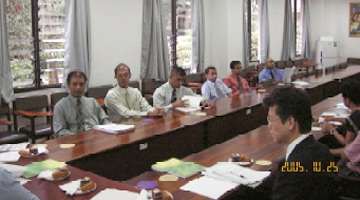
2.Discussion on the Contents of the Program Execution Agreement
Discussion was had regarding contents of the academic exchange agreement to be signed by both institutions in relation to the implementation of the International Course for Oral Life Science. An agreement outline and syllabus details were also explained and topics of discussion.
In addition, an exchange of opinions took place regarding the academic support system at the University of Peradeniya as well the roles of both universities in relation to the course. The discussion ended with a consensus reached regarding the eventual signing of an agreement.
Furthermore, discussion was had in relation to the program's application for funding though MEXT's 2005 Initiatives for Attractive Education in Graduate Schools program. Representatives from Niigata University commented that if selected for funding, they would like to make a mention of it in the actual agreement document. Niigata representatives also asked that the documents contain the signatures of the Niigata University President, the Head of the Department of Oral Life Science, the Vice-Chancellor of the University of Peradeniya, and the Dean of the Faculty of Dental Sciences.
2.Learning Resources and Organizational Infrastructure at the Core University
1.Administrational Review
All important matters with relation to the University of Peradeniya are decided by an internal executive board and review via the university assembly.
The 7 undergraduate faculties, 2 graduate faculties, university library, and various centers are home to their own secretariat offices that operate in close coordination with one another.
Faculty of Dental Science operates under the principles outlined below. Important matters are reviewed by professorial meetings called by the University Chancellor. The various departments and their professors work in close coordination with one another.
Principles of the Faculty of Dental Science
Certified dental surgeons must have:
- 1.Gained extensive knowledge and understanding of the teeth and gums, as well as the healthy and diseased states of their associated structures with relation to diseased oral tissue, loss of teeth, social impairment and degradation of general health.
- 2.Acquired the ability to apply the knowledge and skills gained as above, to diagnose and manage patients' sickness and health states, and when needed, facilitate recovery.
- 3.Acquired extensive knowledge of the healthy state of the oral cavity, and management thereof. Also must have familiarity with general health of the entire body in the case of an onsite emergency.
- 4.Acquired the knowledge and skills required for diagnosis and management in the case of an on-site emergency.
- 5.Gained knowledge concerning the principles of preventative treatment and health education with regard to the conditions as referred to in the 1st provision.
- 6.Acquired the skill to execute the preventative treatment referred to in the 5th provision and be responsible for the health education of individuals, families, and the community on whole.
- 7.Acquired knowledge concerning both the Sri Lankan health care delivery system and the role of a dental surgeon.
- 8.Awareness of the everyday work inside hospital wards and other facilities such as blood banks.
- 9.The ability to work effectively within professional healthcare groups (medical and dental), and when needed be able to act in a supervising or leadership capacity.
- 10.The ability to adapt curative treatment effectively without compromising scientific principles.
- 11.The willingness to continue self-education concerning sickness and health as referred to in the 1st provision in order to be able to continue treatment in a contemporary society.
- 12.The motivation to work towards the established goal of improving the general oral health of the Sri Lankan people.
- 13.Strict adherence to the ethical standards of the dental profession.
- 14.The ability to treat patients with empathy and respect while dispensing medical attention.
(Paraphrased from a University of Peradeniya FoDS Pamphlet)
2.Review of Curriculum, School Code etc.
A summary of the program at the University of Peradeniya Faculty of Dental Science is included. (See attached materials for more info.)
3.Review of Academic Organization
Presently, the University of Peradeniya is organizationally divided into 7 academic faculties with an undergraduate student population of approximately 6,600. The university's 2 postgraduate institutes have approximately 1200 students in total. The university is home to a network of libraries and academic facilities that house its various centers and administrative divisions.
In addition, the University of Peradeniya is home to the only certified educational institution for dentistry in Sri Lanka. Consequently, it acts as a gathering point for aspiring students from all over the country who come to study there and has produced a multitude of highly-skilled graduates. The university also plays a leadership role in the greater Asian region as well, presently hosting clinical researchers from 10 Asian countries including China and India
- Academic Faculties
- The Faculty of Dental Sciences (including the University Hospital) employs a fulltime staff of approximately 60, a part-time staff of 20, and 40 other staff members. Other faculties include the Faculty of Agriculture, the Faculty of Arts, the Faculty of Engineering, the Faculty of Medicine, the Faculty of Science, the Faculty of Veterinary Medicine and Animal Science, the Postgraduate Institute of Agriculture, the Postgraduate Institute of Science, various centers including the Agribusiness Centre, the Engineering Design Centre, the Engineering and Technology Centre, the Centre for the Study of Human Rights, the Center for Environmental Studies, the Information Technology Center and the Agricultural Biotechnology Center.
4.Review of Academic Level
Academic curriculum covered in the Department of Basic Sciences (which includes General and Dental Anatomy, Biochemistry, and Physiology) are highly integrated with lectures, practical training, and individual counseling given by all members of the academic faculty, summing up to 969 hours for first year students. Topics covered in year 2 include Preclinical Science (namely General Medicine, General Surgery, Microbiology and Pharmacology), General Pathology. In Year 3, students take part in the Community Dental Health Program which takes a global view while addressing such issues as Environmental Health. This program takes into consideration societal and economic aspects of regional health issues in an attempt to address them using a pragmatic and methodical approach. Standing on the frontlines of Oral Hygiene cultivates the analytic capacity of the students. Here they get first hand experience with investigative approaches to Oral Epidemiology, Clinical Preventative Dentistry and Basic Primary Care while gaining experience utilizing computer equipment for problem analysis. Before the end of the 4th year, lecture courses and clinical practice in Orthodontics, Pediatric Dentistry, Prosthetic Dentistry, Oral Surgery, Oral Pathology, Conservative Dentistry, Oral Medicine/Radiology and Period ontology must be completed. Students must then pass a strict evaluation process on theory, OSCE, comprehensive oral and practical examinations, as well as course-specific assessment. These academic fields match the current needs of Sri Lankan dental field as well as that of society in general.
Academic research on the other hand, is limited to very basic topics; not from a lack of talented researchers, but because of a distinct lack of advanced research equipment. There is no shortage of articles published in internationally recognized scholarly journals authored by Sri Lankan researchers on specialized topics including epidemiology of oral cancer (of which there is an extremely high rate in Sri Lanka) regional dental hygiene studies and oral epidemiology. Sri Lankan academics who have studied abroad in countries such as the UK or Japan have in many cases taken their results back with them. Should they be provided the necessary environment to further explore their research topics, one would naturally expect continued research productivity.
3.Academic Resources and Physical Infrastructure at the Core University
1.Conditions of Academic Facilities
Due to Japanese economic aid, in the form of ODA etc, adequate facilities were introduced to the University of Peradeniya in the late 1990s. However, while 10 years after construction the buildings are still in a sufficiently usable state, the same can not be said for many of the educational devices that were introduced around the same period. These devices including dental units that hold a fundamental importance in clinical education have been rendered non-functional due to damage incurred during normal use or accident.
In addition, due to its unique status as the only Faculty of Dental Sciences in Sri Lanka, and the fact that the overwhelming majority of equipment was that introduced by Japanese government aid in the late 1990's, there remains is a severe lack of merchants that carry the necessary parts making replacement or procurement difficult. Without support from other Asian countries, specifically Japan, continued maintenance of said educational equipment seems almost impossible.
- 1.Devices used for Undergraduate Education
- Computers: While there are indeed some computers with specifications would qualify as state of the art by current Japanese standards, the vast majority of computers are those would be considered below-average second-hand at best (devices with 500Mhz CPUs with Windows 98 OS).
Basic Educational Equipment (Microscopes etc.): The bulk of optical microscopes are those that were introduced in the late 1990's as part of Japanese aid. An adequate number of microscopes can not be secured for laboratory training because of a range of factors including damage incurred during normal use or accidents. During observation of a 2nd year class it was noted that only 30 microscopes were available for 70 students (the average student population per academic year is 75)
As for Anatomy-related facilities, laboratories and dissection tables were found to be of adequate size and number. However due to types of damage that would only require simple repairs in Japan, only 2 of the more than 8 large scale lighting fixtures were in operation. Present conditions in Sri Lanka are such that the parts required for servicing these are difficult to procure.
LCD Projectors, Screens: Both an LCD projector and screen were introduced in the late 1990's as part of Japanese aid. However the LCD projector has since been rendered unusable due to accidental damage while the screen is in substandard condition due to normal wear. When it was first introduced, this equipment was used by instructors who had returned from Japan to deliver visually clear and effective PowerPoint presentations as part of their lessons. Now, the same lessons are given using old-fashioned over-head projectors that simply project printed course materials. Buying and repairing LCD projectors is difficult because there are very few domestic dealers of these goods. This type of equipment is also extremely expensive by Sri Lankan standards.

- 2.Dental Units and Peripheral Devices used in Clinical Practice
- Dental Units: In the University's Teaching Hospital, dental units are used for the instruction of Clinical Education; the majority of units are those that were introduced in the late 1990's as a form of Japanese aid. Though there are approximately 200 units in total, almost half these are not in an operational state because of a range of factors including damage incurred during normal use or accidents. While most of these units only have minor issues that could be easily fixed in Japan, the lack of domestic parts dealers and the comparatively expensive nature of necessary parts makes procurement extremely difficult. As a result, many of these units do not perform adequately for educational purposes.
X-ray Related Equipment: Whereas it is commonplace in Japan for X-ray related data to be transferred using comparatively high capacity CD media, the equipment used at University of Peradeniya comprised only of older model computers and X-ray equipment using low capacity floppy disk data storage.
There was also a clear shortage of basic hospital equipment including stethoscopes which are considered inexpensive by Japanese standards. Current conditions in Sri Lanka are such that it remains difficult to come by the necessary quantities.
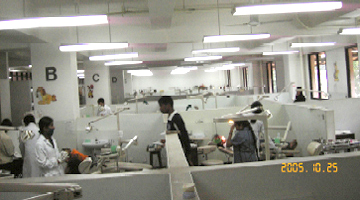
- 3.Laboratory Equipment for Graduate Students and Researchers
- Almost all equipment used in instruction or research purposes was installed in the late 1990's as part of Japanese government aid and is dated by today's standards. However, the university did show a dramatic clinical advantage over Japan in its access to regionally specific dental cases. Researchers brought up in this special environment also carried out their studies in a highly motivated manner. However, our group did observe laboratories where basic equipment including water purifiers and computers were in a state of disrepair because of accidental damage. These rooms also lacked monitoring equipment including electrocardiographic and electromyographic machines which are considered basic by Japanese standards.
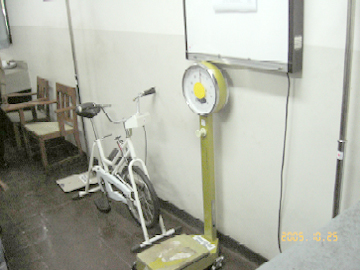
2.Condition of e-Learning Resources
The whole university is LAN outfitted and the Faculty of Dental Sciences has a dedicated computer room equipped with one server and ten common-use computers reserved for education and research purposes.
The LAN's data transfer speed is limited to 100kb/bps which is far from fast by Japanese standards. Of the computers presently in use, very few would quality as state of the art models. Instead the vast majority of computers are those that in Japan could be considered below-average, second-hand at best (devices with 500Mhz CPUs running Windows 98 OS).
Current computing and network conditions do not meet the requirements for the type of e-Learning that our institution is planning to implement. To make such a program a possibility, it was explained that new computing equipment for only e-Learning use must be installed. Network settings would also need to be adjusted to match the protocols of both countries.
Furthermore, Dr. R. L Wijeyeweera, Dean of the Faculty of Dental Sciences, has consented that should new computers be installed and data transfer protocol be updated, the faculty's computer room could be used as a classroom for e-Learning purposes.
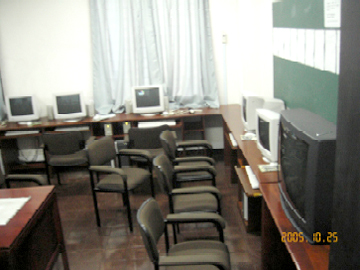
4.Country Background
Sri Lanka's basic economic data is as stated below. (Source: Central Bank of Sri Lanka)
- 1.Population:
- 19, 010,000 (2002 est.)
- 2.Nominal GDP:
- 16.57 billion USD (2002 market price)
- 3.GDP-per capita:
- 872 USD (2002 market price)
- 4.GDP-real growth rate:
- 4.0% (2002 est.)
- 5.Currency:
- Sri Lankan Rupee (1 rupee = 1.22 Yen, 1 USD = 96.752 rupees 2002 end of year value)
- 6.Trade:
- Export (FOB) 4.7 billion USD (2002)
Imports (CIF) 6.1 billion USD (2002) - 7.Current Account Balance:
- 260 Million USD (2002)
- 8.Reserves of Foreign Exchange:
- 2.5 billion USD (2002)
- 9.Inflation Rate of Consumer Price Index (Colombo):
- 9.6% (2002)
- 10.Unemployment Rate:
- 9.2 % (2002 est)
1.State of Society, Cost of Living, and Public Safety Review
- 1.State of Society
- The region between the capital city Colombo, the location of the airport, and Kandy, where the University of Peradeniya is located, has since the February 2002 cease-fire agreement, remained in a stable state with no incidents that show a breakdown of said agreement.
On July 7, 2004 there was a failed assassination attempt on the head of the Tamil political party and on August 12, 2005 the foreign minister was assassinated. These incidents have been interpreted as actions targeted against particular individuals rather than signs of a general worsening state of public order. Apart from Terrorist activities, there is an increase of household burglary and robbery; however the general state of domestic public order as a whole is a stable one.
However, the ongoing peace process between the government and the LTTE hints at the potential of future instability. Therefore further steps must be taken in information collection and safety planning.
Damage incurred as a result of the 2004 Asian tsunami has been mostly restored in most areas with the exception of some areas on the western coast that were particularly devastated. In the Colombo area, which was spared the brunt of the tsunami's destructive force, remnants of the damage were not particularly noticeable. - 2.Cost of Living
- Sri Lanka has in the past been an agriculturally-based economy, relying primarily on the production of rice and the 3 big plantation goods of tea, rubber and coconuts. However, recent industrialization has led to a diversified economy whose largest export is in textile goods.
In response to the post-1983 economic recession, the Sri Lankan government agreed to structural adjustment policies made by the World Bank and IMF to cut fiscal expenditures, privative public corporations, and ease regulations on foreign exchange control starting 1988.
Partially due to this change in economic policy, the area between the capital Colombo and Kandy are home to increased foreign investment.
Because of the relative income disparity of most citizens it is difficult make an accurate comparison, however a generally accepted estimate is that the income of the average salaried worker in Sri Lanka is one tenth that of their Japanese counterpart.
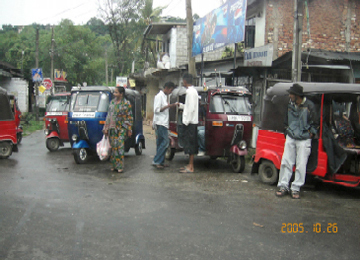
- 3.Public Safety
- As a result of the August 12, 2005 assassination of the foreign minister in his private residence in Colombo, the government announced a state of national emergency. Investigations were opened to apprehend the responsible parties and security details of important governmental facilities were increase. Seeing patrolling soldiers equipped with automatic weapons is now commonplace. It is possibly because of this increase in security that present public safety conditions within Colombo are on average quite good. The assassination incident has been interpreted as a strike against a particular individual (in this case a government official), rather than an act of indiscriminate terrorism meant to disrupt the lives of everyday people. However since there is no guarantee that future incidents will follow this trend, civilians are advised, when possible, to avoid important government or economic areas so to decrease the likelihood of adverse risk.
Areas to the north and east are controlled by the extremist LTTE (Liberation Tigers of Tamil Eelam) who claim separate and independent rule of the region. The LTTE engaged in armed conflict with government forces until the signing of the cease-fire in 2002. To date, with the exception of one violation, both LTTE and government forces have adhered to the cease-fire. However, since the vast majority of the north and east regions remain out of government control, it appears that it will take some time before a lasting state of public safety can be assured there.
Excluding the north and east areas, Sri Lanka enjoys a relatively stable level of public safety. However, since each region has its own special circumstances it is advised that visitors keep abreast of the latest news and information before setting out. Since the establishment of the ceasefire agreement, government and LTTE representatives have engaged in 6 separate peace talks. However negotiations have been put on hold since April 2003 because of a disagreement regarding the terms of the ceasefire. Present conditions make it difficult to say when negotiations will be re-opened. Since peaceful relations between the Sri Lankan Government and the LTTE are necessary for continued public safety for not only the northern and eastern occupied territories, but for all areas of Sri Lanka, it is important to keep a close eye on developments in the peace process.
2.Review of Education Policy
Education policy in Sri Lanka is divided into annual intervals of 5 ・ 4 ・ 2 ・ 2. Elementary education extends for 5 years and lower secondary education for 4 after which a 2 year period of upper secondary education is reserved for preparation for national-standardized tests known as the O-Level Examinations. Only students who have passed O-Level exams may apply for the subsequent 2 years of high school after which they must pass A-Level examinations to become eligible to apply for university.
Of those who enter elementary school, 70% pass O-Level examinations. Of those who pass these exams only 36% of continue to high school. Entrance to university is an even higher hurdle which only 10% of high school graduates overcome. Since majority of students leave school after secondary education or high school, the acquisition of practical skills including foreign languages is very popular.
3.Academic Research/Diagnosis of Oral Disease
Please refer to diagram 2-4 for information regarding academic research on oral disease.
As for treatment, other than the existence of some nonfunctional dental units, the use of dental units in general dental care was not particularly different from the type of care patients receive in Japan. As its popularity as a gathering ground for clinical trainees from various Asian countries shows, the clinical education staff of the University of Peradeniya do not sacrifice quality when instructing a large student body. At the time of the team's inspection, inpatient occupancy levels were at 100%. This is mostly due to Sri Lanka's special status of being home to one of the world's highest incident rates of oral cancer and pre-malignant lesions (leukoplakia, erythroplakia, lichen planus, submucosal fibrosis etc). This high occupancy rate suggests an ample supply of study cases for Oral pathology, Oral surgery. The logical conclusion of this high rate of exposure is that diagnosis and treatment techniques have improved. Also, though our group was not able to witness it first hand, we were informed of school-based teams that provided primary care (including dental) to depopulated areas with no dental or medical care facilities. Examples of such programs help highlight the kind of environment that influences dental care in Sri Lanka.
5.Conclusions
Based on the review described in sections 1-4, the following section explains why it was concluded that this program could be implemented without sacrificing the quality of education.
- This program has received the full support of the University of Peradeniya Faculty of Dental Sciences.
- The educational program being implemented at the University of Peradeniya was found to be in no way inferior to similar programs in Japan. In fact, the university continues to carry out a highly enterprising educational program that highlights its regionally specific research topics. The current level of education is one that provides no impediments for the successful implementation of this program.
- The faculty's basic and clinical educational facilities and equipment, though humble by some standards, can easily be functionally restored with only a small degree of assistance thus assuring even greater educational development.
- The state of the school's research facilities and equipment is similar to those related to education. Though humble by some standards, such facilities can be functionally restored with only a small degree of assistance thus assuring even greater research development.
- The ability to remain in Sri Lanka while simultaneously earning a degree from Niigata University drastically cuts the financial burden for participating students. Also since there is a decreased risk of talented students leaving the country after acquiring their degree, the Sri Lanka is able to secure a pool of talented future researchers. It was agreed upon by both universities this would be beneficial to both the University of Peradeniya and the Sri Lanka Dental Association.
- Both universities agreed that the execution of this program, first in Sri Lanka and expanding to the peripheral Asian region, succeeded in making a contribution to the international community by offering venue for Asian researchers to showcase their achievements.
- Regarding the types of research themes to be studied by the students, it was decided that rather than focusing on topics that required state-of-the-art technology, focus would be placed on exploring themes specifically related to the Asian region and accumulating a basic set of data to base said research on. It was also decided that it would be possible to structure an adequate program of graduate study based on research topics centered on especially Sri Lankan themes.
- Regarding e-Learning, it was found that while there was a real necessity for the upgrade of computing devices and network bandwidth, the basic setup was found to provide no real barriers for future implementation.
- Though some of the necessary educational equipment was not in operational condition due to age or accidental damage, repairs could be made at little cost. While there needs to be follow-up to ensure adequate educational resources, it was the opinion of the review team that such conditions did not provide a real barrier to program implementation.
 Initiatives for Attractive Education in Graduate Schools
Initiatives for Attractive Education in Graduate Schools






